#india gate tour guide
Text

India Gate is the best monument to visit in Delhi. It is a majestic war memorial located in the heart of New Delhi, India. Standing tall at 42 meters, it was built to commemorate the 70,000 Indian soldiers who died fighting for the British Army during World War I and the Third Anglo-Afghan War
0 notes
Text
Taj Mahal Day tour by India Taj Tours Company.
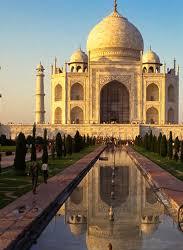
India Taj Tours Company's Day Tour of the Taj Mahal
Unquestionably captivating, a day trip to see this famous structure ensures that visitors will never forget their experience. You can count on an itinerary that has been painstakingly crafted by India Taj Tours Company to make the most of your trip.
Why Opt for Taj Tours Company in India?
The India Taj Tours Company is highly known for its carefully planned itineraries and outstanding service. Their day trip to the Taj Mahal is planned to give you a smooth experience from the time you check out of your hotel until you return.
Early Morning Departure
The tour starts early in the morning when you leave your Delhi hotel. Your air-conditioned, cozy car will be ready to whisk you away on a picturesque trip to Agra so you can arrive rested and ready to explore.
Arrival in Agra
A native guide will meet you when you arrive in Agra and provide you enlightening information about the rich history and culture of the city. The Taj Mahal is, of course, your first stop.
Investigating the Taj Mahal
You will be astounded by the Taj Mahal's utter magnificence and splendor as soon as you enter its gates. A masterwork of Mughal architecture, the white marble monument was constructed by Emperor Shah Jahan in honor of his beloved wife Mumtaz Mahal.
Tour Guided
Your guide will regale you with amazing tales regarding the building of the Taj Mahal, its historical significance, and the love tale that inspired it. You'll have plenty of time to snap lots of pictures, tour the grounds, and the main mausoleum.
During lunch
Following your tour of the Taj Mahal, you will be escorted to a nearby eatery where you will savor a delectable meal of authentic Indian fare.
A visit to the Agra Fort
You will next proceed to another UNESCO World Heritage site, Agra Fort. In addition to providing breathtaking distant views of the Taj Mahal, this red sandstone fort provides insight into the lavish lifestyles of the Mughal emperors.
Investigating the Neighborhood Market
You'll have time to visit the Agra local marketplaces before returning to Delhi. Shopping for mementos, such as fine marble inlay work and traditional crafts, is a terrific chance.
Go back to Delhi
With pleasant recollections of a day well spent, the tour ends with a leisurely drive back to your Delhi hotel, where you will arrive in the evening.
In summary
The ideal approach to see one of the most stunning sites on earth is with an India Taj Tours Company day trip to the Taj Mahal. A well-thought-out itinerary, comfortable transportation, and knowledgeable guides ensure that you have a day to remember.
FAQs
What should I pack for the day trip to the Taj Mahal?
It is advised to wear walking shoes and comfortable clothing. It's a cultural site, so please dress modestly.
Is it allowed to snap pictures inside the Taj Mahal?
Tripods are not allowed, but taking pictures is okay.
Is lunch included in the price of the tour?
Yes, the package includes a delectable lunch at a nearby restaurant.
Which season is ideal for seeing the Taj Mahal?
The milder months of October through March are the ideal times to visit.
How far does it take to get to Agra from Delhi?
Depending on the state of the traffic, the travel takes three to four hours.
2 notes
·
View notes
Text

The then newly-restored plaque in St. Mary’s Square honoring the “Americans of Chinese Ancestry” who gave their lives for America in its world wars, November 10, 2018. Photograph by Doug Chan.
The Last Full Measure: St. Mary’s Square Monument to the Fallen of Chinese America
In his book San Francisco Chinatown: A Guide to its History & Architecture, historian Philip P. Choy, shared his observations about the monuments in St. Mary’s Square as follows:
“Across from the statue of Dr. Sun Yat-sen is a less imposing but more significant monument, with 97 names of Chinese American soldiers of our community, who made the supreme sacrifice in World War I and II. Every year on Veterans Day, the Cathay Post No. 384 and the VFW Chinatown Post march to the square to honor those who died for us, that they never be forgotten. This commemorative plaque and day of remembrance are more symbolic of Chinese America than Sun Yat-sen’s statue and the “Ten Ten” celebration.”
During the Second World War, thousands of young men and women enlisted or were drafted from Chinatowns, Japantowns (and concentration camps), Manilatowns, and other small communities across the country.
According to the U.S. Department of Veteran Affairs and researchers at the Oakland Museum, 13,499 Chinese American men fought in the armed forces. (Community estimates range as high as 20,000.) Approximately 75 percent served in the US Army, with ground units such as the 3rd and 4th Infantry Divisions in Europe and the 6th, 32nd and 77th Infantry Divisions in the Pacific. A quarter of the total Chinese American personnel under arms served in the Navy. Still others served in specialized units, such as the all-Chinese American 1157th Signal Corps -- part of 14th Air Service Group that would join the fight against Imperial Japan in the China Burma India theatre of operations.
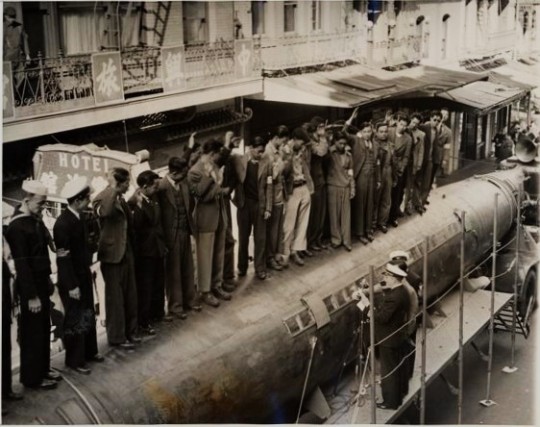
Group of Chinese recruits for the U. S. Navy taking their oath on top of a captured Japanese submarine, on Navy Day in San Francisco Chinatown, October 27, 1942. Associated Press photographer unknown (from the collection of the San Francisco Public Library). As written on the verso: ""A two-man Jap submarine, captured after the sneak attack on Pearl Harbor, T.H. [Territory of Hawaii], began its nation-wide tour in San Francisco Oct. 27. In Chinatown, Chinese recruits for the U.S. Navy lined up on the vessel and took their oath. It was part of Navy Day ceremonies."
The Chinese American men who served in the armed forces during WW II comprised 20 percent of all such men in the continental U.S. As historian Iris Chang would write decades later, “ethnic Chinese men gave their lives disproportionate to their presence in the country.”
As in many cities, the public spaces in San Francisco had included memorials to the fallen in America’s wars. On Memorial Day on May 30, 1919, city officials and thousands of spectators dedicated a 15-acre plot as the “Grove of Heroes,” in remembrance of the US dead and wounded in the First World War. In 1930, a sculpture originally created by M. Earl Cummings for the Pan Pacific International Exposition was acquired and installed in the meadow adjacent to the grove. The bronze figure holding a laurel wreath became known as the “Doughboy Statue,” and it is readily noticeable from the park’s John F. Kennedy drive and promenade. On Armistice Day (now known as Veterans Day), November 13, 1932, public officials assembled again to dedicate an 18-ton granite boulder (reportedly quarried from Twin Peaks) to commemorate US war dead. The monument, which was sponsored by the Native Sons of the Golden West, was inscribed with the names of 748 men and 13 women, all local soldiers and volunteers who died during the Great War.
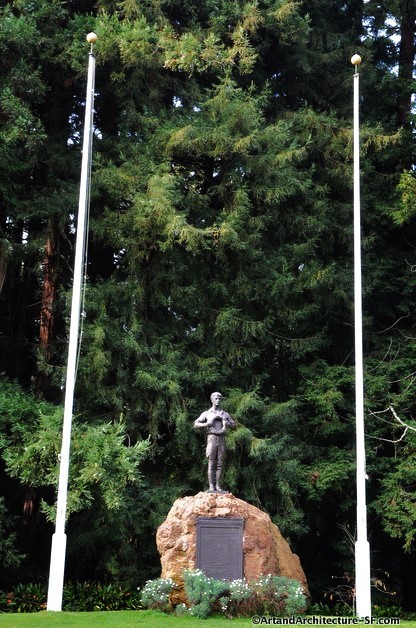
The Doughboy Statue in the “Grove of Heroes” in San Francisco's Golden Gate Park. The plaque, sponsored by the Native Sons of the Golden West and inscribed with the names of US dead in two world wars, omits the names of non-white military personnel killed in the line of duty.
Although Chinese Americans had served and died in WW I, no Chinese names had ever been inscribed in any of San Francisco’s war memorial monuments from that era. Their omission was hardly surprising. The Native Sons of the Golden West had been founded in July 1875 as a fraternal organization "embracing only the sons of those sturdy pioneers who arrived on this coast prior to the admission of California as a state." In the 1920s, the Native Sons adopted a white nativist stance on public policy issues. President William P. Canbu of the Native Sons wrote that “California was given by God to a white people, and with God’s strength we want to keep it as He gave it to us.” The Native Sons openly opposed Chinese, Mexican, and Japanese immigration. At the outset of the Second World War, the organization waged an unsuccessful legal battle for Japanese Americans to be disenfranchised.
The size of the returning cohort of Chinese American men (and the few women) from the Second World War had been unprecedented, and they produced a transformative generation of determined civic activists in the postwar era. As was the case with many other communities of color in the country, Chinese Americans had to struggle for acceptance and civil rights. Community activists such as John C. Young, a retired colonel from the United States Army and World War II veteran, made it their mission to join the struggle for Chinese Americans’ civil rights and participation in mainstream society. Young’s family led that effort by example as one of the first Chinese families to buy a home in defiance of racially-restrictive covenants against homeownership in San Francisco’s Richmond District (See the story here: https://www.outsidelands.org/chinese-in-the-richmond-alfred-john-young-and-connie-young-yu.php)
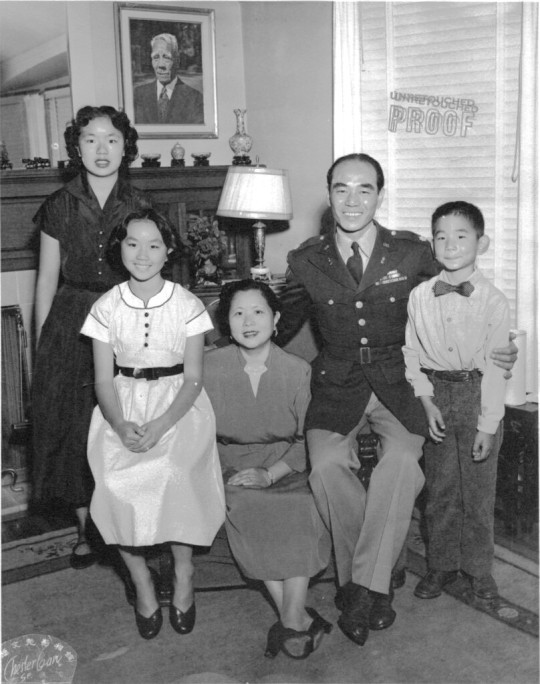
Left to right: Janey Young Cheu, Connie Young Yu, Mary Lee Young, Lt. Col. John C. Young, and Alfred John Young in the Young family house at 674 37th Avenue, circa 1952. (Courtesy of Al Young)
With the onset of the Cold War and actual armed conflict on the Korean peninsula, Chinese American leaders sensed that the path toward progress and acceptance of Chinese Americans had been jeopardized by the People’s Republic of China’s deploying troops to support North Korea’s military against UN forces.
As a commander of the American Legion Post #384 (Cathay Post), John Young and his fellow veterans spearheaded a proposal to erect a war memorial to the fallen Chinese American Veterans of World War I and World War II.
In 1951, the same year in which the Native Sons added the names of 16 white members who had died in World War II to the plaque on the rock pedestal of the Doughboy Statue, Chinese American veterans’ proposal to honor their fallen comrades in Chinatown gained acceptance.
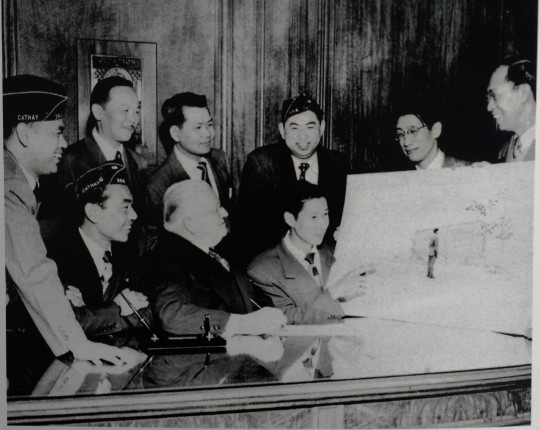
Members of the VFW Chinatown post and Cathay Post no. 384 of the American Legion huddle and review conceptual drawings for a St. Mary’s Square monument with San Francisco Mayor Elmer Robinson in the Mayor’s office in City Hall, c. 1951. Standing (left to right): Lim P. Lee, Peter H. Wong (unidentified veteran), Shaw Pange, Charles Leong, and Joseph Quan. Sitting: John C. Young, Mayor Elmer Robinson, and James Hall. Photographer unknown (from the collection of the late Col. John C. Young and his daughter Connie Young Yu).
Before 1951, a large and dramatic stainless steel statue of Dr. Sun Yat-sen, designed local sculptor Benny Bufano, represented the principal statuary in St. Mary's Square.
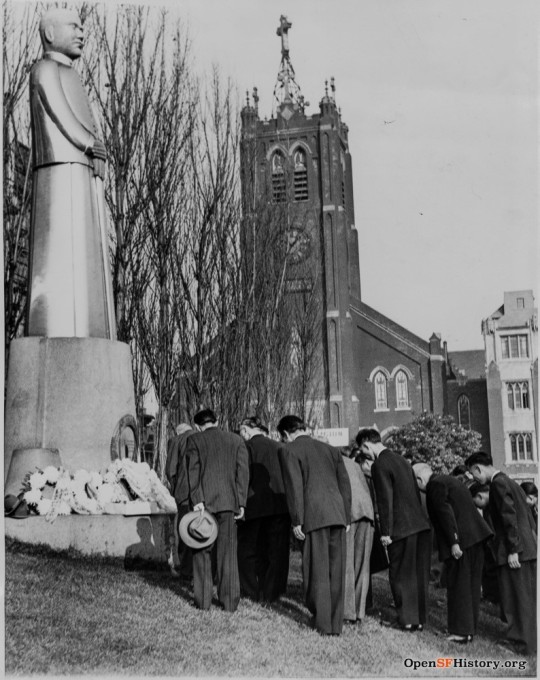
St. Mary's Square Nov 12, 1943. In this view of St. Mary's Square, looking north toward Old St. Mary's Church, members of San Francisco’s Chinese community bow before the statue of Sun Yat Sen on the occasion of Dr. Sun’s birthday. Among those attending the ceremony was Tse Kiong Sun, grandson of Sun Yat Sen. Photographer unknown (Courtesy of a private collector).
According to historian Phil Choy, the statue had been commissioned by the Chinese Six Companies to commemorate October 10, 1911, the day Dr. Sun's revolutionary party overthrew the Manchu government and established the Republic of China. As Choy wrote in 2012:
“For almost a century, October 10th, known by the Chinese as “Ten Ten,” was a major day of celebration in the community. Banners stretched across Grant Avenue. Organized by the Chinese Six Companies, drum & bugle corps and pupils from every Chinese language school dutifully paraded through the streets. Today the celebration no longer has 100% community support. Members of the Chinese Six Companies are divided; some still embrace the Kuomintang (KMT) Party of the former Republic of China (now the Taiwanese Government), while others support the People’s Republic of China.”
The efforts by the Chinese community’s veterans and supporters to honor the fallen of two world wars culminated in 1951 with the installation of the memorial plaque still seen today in St. Mary's Square. (A recounting of the memorial's dedication and other recollections by the daughter of one of the leaders in the effort to establish the monument, historian Connie Young Yu, may be heard here. (https://chiamgi.substack.com/p/col-john-c-young-profile?triedRedirect=true)
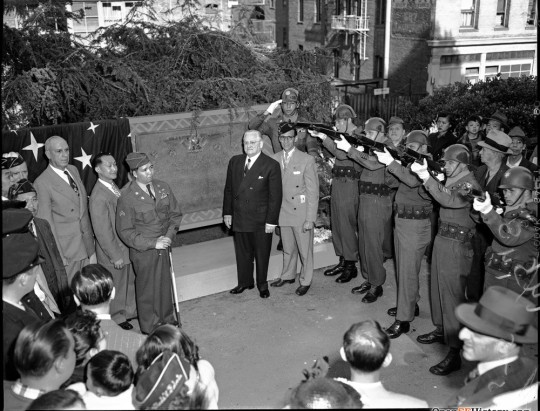
“Soldiers firing salute at dedication of memorial to deceased Chinese-American veterans at St. Mary's Square,” May 28, 1951. Mayor Elmer Robinson stands at center in dark suit. Photographer Unknown (Examiner Negative Collection / courtesy of a private collector)
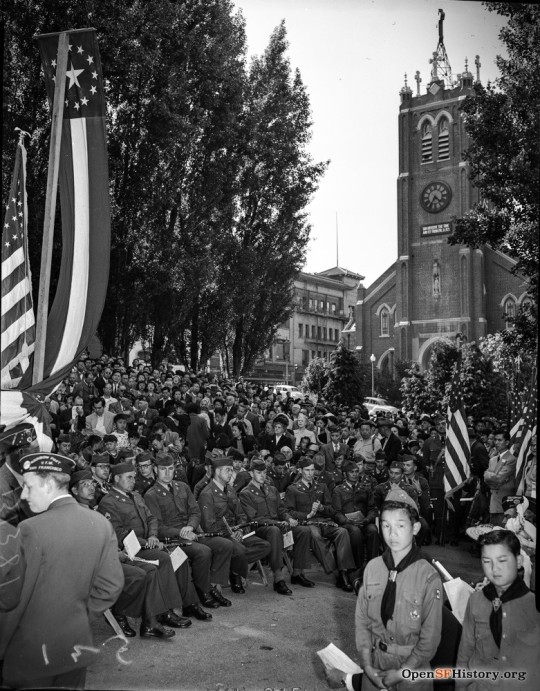
A large crowd attended the dedication ceremonies for the Chinese veterans memorial at St Mary’s Square on May 28, 1951. An Army band is seated with musical instruments, and members of the Chinatown Boy Scouts troop appear in the right foreground. Photographer unknown (form a private collection).
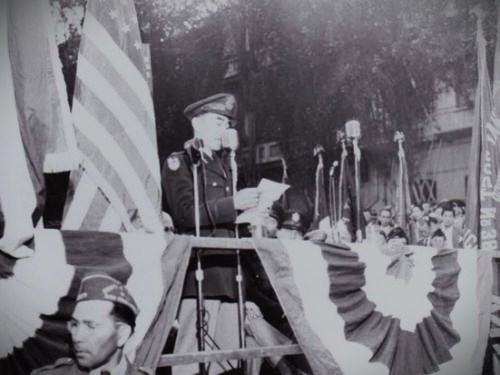
Civic leader and president of the Wing Nien Soy Sauce Co. Col. John C. Young (ret.) speaks to the crowd assembled on May 28, 1951, for the dedication of the memorial to Chinese American service personnel killed during the First and Second World Wars. His speech to the crowd occurred in the presence of his former commanding officer, General Albert Wedemeyer, under whom Young served as a heavy weapons officer in the China-Burma-India theater of operations.
If the irony of Chinese Americans' entering the US armed forces during wartime was apparent, it was never expressed publicly by those who had served honorably. Native-born, as well immigrants ineligible to naturalize as citizens by punitive immigration laws, had answered the call to service for an America that had, for most of the previous century, robbed, murdered, burned, lynched, taxed, and excluded the pioneer generations, while building much of the political economy of the American West on the strength of Asian labor.
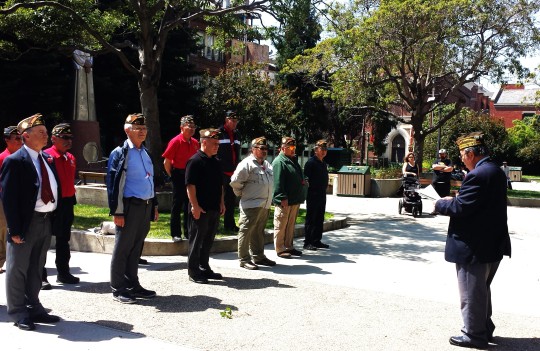

Veterans from Chinatown's American Legion Cathay Post 384 and VFW Chinatown Post 4618 assembled on Memorial Day 2016 in front of the WW I and II memorial plaque in St. Mary’s Square to commemorate the Chinese American fallen in all the nation’s conflicts and wars. Photograph by Doug Chan.
The numbers of Chinese Americans KIA and MIA from the world wars remain imprecise. The honored dead, including Medal of Honor recipient Capt. Francis B. Wai are, and will be, remembered in perpetuity for their extraordinary heroism and devotion to duty. For others, such as Lt. Kenneth Kai-Kee, the memories, grief and loss of those he left behind have already faded with the passing of family, friends, and loved ones.
The passage of time confers on community historians the duty to impart to each new generation the mission to remember the wartime sacrifices of Chinese America's sons and daughters. The debt to those who gave the last full measure of devotion must be honored in perpetuity.

Photograph by Doug Chan.
#St. Mary's Square#Cathay Post veterans#Col. John C. Young#Francis B. Wai#Kenneth Kai-Kee#Lim P. Lee#Peter H. Wong#Shaw Pang#Charles Leong#Joseph Quan#Chinese American veterans memorial
2 notes
·
View notes
Text
Best Golden Triangle Tours - Delhi - Agra - Jaipur
Best Golden Triangle Tour Package with Tiger Safari- Ranthambhore
tajmahaltoursandtravels
No Comments
Golden Triangle with Ranthambhore, India
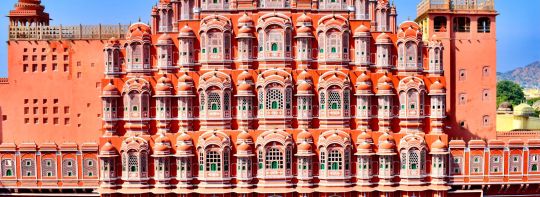
Overview
Best Golden Triangle Tour Package,: Take a sightseeing tour of Delhi, Agra & Jaipur, together called the Golden Triangle, and get an incredible wildlife experience at Ranthambore National Park, with our 07 Nights/08 Days Best Golden Triangle Tour Package with Ranthambore National Park.
Your tour begins in Delhi where you will be received by our representative. Proceed with a Delhi City Tour, which covers Humayun’s Tomb, India Gate, Raj Ghat & Shanti Vana. Reach Jaipur by car & visit its famous tourist places like Amer Fort, Jantar Mantar & Maharaja’s City Palace.
Reach Ranthambore from Jaipur via a car drive. Enjoy morning & afternoon wildlife safaris in a 06 seater shared open jeep with an expert guide & driver. Spot the Royal Bengal Tiger & other wild animals in their natural habitat.
From there, head to Agra, where you will visit the magnificent Fatehpur Sikri, Taj Mahal & shop in its bustling markets, famous for their marbles, spices, handicrafts & glassware, among other things.
During this tour of Best Golden Triangle Tour Package, you will enjoy a stay at the best hotels in Delhi, Jaipur & Agra, and have the memorable experience of staying in a wildlife resort at Ranthambore, in the middle of nature. Get the smoothest transfers & meals & transport, and have a great time!
Itinerary : Best Golden Triangle Tour Package
Day 01
Arrival Delhi
Other Benefits (On Arrival)
Breakfast
Transfers
Stay Included
On your arrival at Delhi International Airport you will be welcomed by our representative, you can find him easily as he will be there at the arrival lounge holding a Placard of your name. After meet & greet transfer to your pre booked hotel. Overnight stay in Delhi.
Day 02
Delhi City Tour : Best Golden Triangle Tour Package
Delhi City Tour
Morning at leisure, After breakfast around 09:00 AM start your city tour of Delhi with an exclusive car & expert English speaking guide, you also can opt for your preferred language guide by prior information or at the time of booking the tour. On first half day Visit Raj Ghat and Shanti Vana, drive past Red Fort and Chandni Chowk. Afternoon the second half of the day visit Qutub Minar built by Qutub-ud-Din Aibek in 1199, Humayun’s Tomb, India Gate (War Memorial Arch ), Lakshminarayan Temple – a modern Hindu Temple. Also drive past President’s House, Parliament House, and Government Secretariat Buildings & Connaught Place. Evening visit shopping centres in Delhi. Overnight stay in Delhi. Best Golden Triangle Tour Package
Meals: Breakfast
Activities: Delhi City Tour
Note: On Monday a few monuments are only closed viz Red Fort, Akshardham Temple and Lotus Temple etc. So you would be able to see many places even though on Mondays.
Day 03
Delhi – Jaipur (By Car)
Visit to Local Market of Jaipur
Morning at leisure after breakfast Drive to Agra. On arrival at Jaipur check-in to the hotel. Afternoon explore local market of Jaipur, enjoy shopping at Jaipur Market, Jaipur is better known for its royalty and the wonderful monuments but there are list of endless things that make it a must visit shopping destination. Evening Return to your hotel for a comfortable overnight stay.
Activities: Visit to Local Market of Jaipur
Meals: Breakfast
Day 04
Jaipur
Jaipur City Tour
Elephant ride at Amer Fort
Morning an early breakfast visit Amber Fort. Start early at 8 am from Amer Fort as the elephant rides ends at 11 am. By doing so, you not miss out on elephant ride. Amber Fort was the ancient capital of the State. Visit the Sheesh Mahal or the Hall of Victory glittering with mirrors. Ascend the Fort on Elephant back. Afternoon tour of Jaipur. Jaipur – the capital of Rajasthan was given a colour coat of pink a century ago in honour of a visiting Prince and ever since, it has retained this colour. Built by Maharaja Jai Singh, the notable astronomer, this city is 260 years old. Visit Maharaja’s City Palace, Jantar Mantar features the world’s largest stone sundial & Ram Niwas Gardens. Drive past Hawa Mahal & through the pink rose residential & business areas. Overnight stay at the hotel in Jaipur.
Activities: Jaipur City Tour, Elephant ride at Amer Fort.
Meals: Breakfast
Day 05
Jaipur – Ranthambore (By Car)
Jeep Safari
Morning at leisure, after breakfast straight drive to Ranthambore National Park. Arrive Ranthambore & Check-in to the Wildlife resort. After lunch get ready to board afternoon jeep safari vehicle, Safari will be with 06 seater shared open jeep with expert naturalist & Driver who are well aware of all proximities of the national park to provide you best wildlife safari experience. 03 hrs to witness wildlife. After finishing safari return to resort, enjoy your evening at the resort with Rajasthani folk music & dance arranged by resort management on every alternate evening. Dinner & Overnight stay at the wildlife resort.
Activities: Afternoon jeep safari.
Meals: Breakfast, Lunch & Dinner
Day 06
Ranthambore National Park
Jeep Safari
Morning self-service at you room for tea / coffee & get ready to board morning jeep safari vehicle, After finishing AM safari return to resort, breakfast & free time for leisure, relax or to enjoy resort activities like swimming pool, indoor outdoor games etc. Ranthambore is one of the finest tiger reserves of India and considered the best place to spot a tiger in his own natural habitat. The park is also popular with the wildlife photographers. After Lunch Afternoon jeep safari for the national park, Enjoy your evening at the resort with Rajasthani folk music & dance arranged by resort management on every alternate evening. Dinner & Overnight stay at the wildlife resort.
Activities: Morning & Afternoon jeep safari.
Meals: Breakfast, Lunch & Dinner
Day 07
Ranthambore – Agra (By Car)
Visit to Local Market of Agra & Fatehpur Sikri
Morning at leisure after breakfast Drive to Agra. En-route stop to visit Fatehpur Sikri. Visit the Palace with the majestic Buland Darwaza built in 1576. Visit the pious place – the tomb of Salim Chishti, which is known for fulfilling wishes of its devotees. This city has palaces built in red sand stone and is a site that shows perfect amalgamation of Indo Islamic architecture and culture. On arrival at Agra check-in to the hotel. Evening visit to Local market of Agra, Agra is one of the best places in India for shopping particularly, handicrafts and souvenirs of Agra are very popular, clothing, jewelry, fabrics, shoes, marble, spices, handicrafts, glassware, and leather products are the available things to buy in Agra. Return to your hotel for a comfortable overnight stay.
Activities: Visit to Local Market of Agra & Fatehpur Sikri
Meals: Breakfast
Day 08
Agra – Delhi – Departure (By Car)
Visit to Taj Mahal & Agra Fort
Morning at Sunrise visit the extravagant monument Taj Mahal. Taj Mahal, entitled as one of Seven Wonders of the World, is a must visit to witness the masterpieces of Indian architecture. The Taj Mahal is one of the most impressive buildings in the world and it is rightfully famous. There is a reason that everyone has heard of it and everyone should visit it. After breakfast visit the Magnificent Agra Fort. Later Drive back to Delhi, on arrival in Delhi in time transfer to Airport to board the flight for home country.
Meals: Breakfast
Activities: Visit to Taj Mahal & Agra Fort.
Note: Taj Mahal remain close for visitors on every Friday.
#tours and trav#tourist attraction#tourism#travelling#vacation#holiday#travel#incredible india#rajasthan tour operator#rajasthan#kerala#kerala tour package
2 notes
·
View notes
Text
Its one of those days i couldn't sleep because the world is beautiful and pretty and,,, i mean. We went to ranthambore and ran into a tiger at the gate. It stood to the left and watched our jeep pass by. We saw it again a dew hours later. We went to thar and traveller quite far, first on normal jeeps, then ones designed specifically for sand (my hair whipped all over my face from the wind from how fast it was going, and i looked kinda freaky) , then on long trains of camels and finally we played for hours on a sand dune and watched the sun set and ive never experienced anything like that again, because there isnt anything like that i don't think. We saw a fox at bharatpur - we saw plenty of birds, too, but i only remember the fox for some reason, it was years ago - and once we were returning from rishikesh and my father called a pair of foxes that we simply ran into as "unfed dogs" and i think aboutthat to this day. We'vebeen to sikkim, and a bridge collapsed so on the third or fourth day of our trip we crossed a river by foot on a very unstable mountain and thats not an experience i will ever forget, it was dangerous but so fun. I slipped and fell into a riverlet a dew days after that and it was cold. In a different trip we ate maggi at the last restaurant of india in the Himalayas... i forget where it is, but it had been a surreal experience. Waking up to the sounds of sparrows and crows and mainas in munsiyari. Following a group of dogs to a temple, as if they were our tour guides for the day. We met a lady with a goat called Kaju (cashew) and she said it was named by someone from the same city as me, another tourist who passed by months ago. She let me hold the goat and it was so soft and precious. A vulture landed near our house the other day. Thats not normal. That was the first time i had ever seen one. Vultures are big. That thing was easily twice or thrice the size of the kites we get. One of those kites tried to bother it but its attempts failed and it went away. The vulture stayed in the same spot for at least 20 hours before it left. A friend told me that i should have called animal services, because that's not normal.
I've fed cows and dogs and crows by hand. It's a precious feeling. The crow looked right in my eyes and that was the first time i understood how smart they are. You can see it in their eyes. You can see it in a cow and a dog and a fox and in tigers and lions and squirrels and birds. We went to the east coast of the US and the squirrels there are so much bigger than ours. We've been to europe and this guy just... picked a pigeon off the street and put it on my arms before i processed whats going on. We rode a ship from britain to somewhere, i didnt understand much of the trip i had no clue what i was doinf, and theres nothing really like that. And theres nothing like seeing the clouds from a plane or talking to people as the scenery passes by on a train or,,,
Its just one of those days that i think about how pretty and beautiful the world is
#duckbang posts#desiblr#Im not sure how totag this so I'll leave it untagged for now#Feel free to rb
3 notes
·
View notes
Text
Day 12 : Ratten Villas - Jodhpur
20th March 2023
The cake was delicious, light and creamy and went very well with a glass of red wine 🍷
We all wore our finery yesterday evening and were ready for our anniversary meal, unfortunately the rain that had been threatening all day decided to pour down just as our evening was starting.
It was a double edged sword really because on the one hand the rain was a welcome respite from the heat and on the other, we were unable to have our meal in the garden.
Unfortunately the restaurant had all the ambience of a mortuary, it was cold, lifeless and sterile. Not to be deterred we ordered our meals, relishing the thought of the distinctive Rajasthani food, which turned out to be not so delectable after all as it was far too salty. To be absolutely certain my tastebuds weren’t playing up, I shared my meal out and we all agreed on the same.
So there was a storm raging around us, my meal was awful, so what else could go wrong ? Plenty as it turns out.
I was mildly irritated by the time we got back to our room but not enough to be upset, after all I wasn’t charged for the disastrous food I had chosen for myself.
The door was locked, the shower was on except it didn’t work, the joy stick controlling the water speed and the temperature was hanging off the metal bit that should have held it on. To add insult to injury as I called Tony for assistance, I walked slap bang into the shower door.
Nursing my bruised nose, I finally managed to get showered and ready for bed.
We woke to glorious sunshine this morning and had a very passable breakfast in the garden after which we met our guide for a tour of Mehrangarh Fort.
Mehrangarh Fort holds the pride of place in Jodhpur because of its splendid architecture and the diverse history associated with it. Considered as one of the most formidable and magnificent forts of Rajasthan, Mehrangarh fort was built by Rao Jodha in the year 1459. The fort is spread over an area of 5 km and is built on 125 m high hill in the outskirts of Jodhpur city.
There are seven gates, which can be used to enter the Mehrangarh fort. These 7 gates are made by different rulers, and are built in honour of victory over Bikaner and Jaipur armies.
You can see the panoramic view of the Jodhpur city from this fort, which seems like a blue carpet laid at the foot of a hill.
Once we had got extremely hot and sweaty, we rejoined our driver for a short drive to Jaswant Thada.
The Jaswant Thada is an architectural marvel with intricate carvings. Famed as one of the most beautiful white marble cenotaphs, it was built in 1899 by Maharaja Sardar Singh in commemoration of his father Maharaja Jaswant Singh II. This white marble wonder of Rajasthan is often called the Taj Mahal of Marwar. The splendid edifice is a perfect example of Rajputana style of architecture. Its impeccable design and architecture is symbolic of the fine craftsmanship of the bygone era.
The main memorial is built like a temple, with beautiful domes and finely carved sculptures.
We had a quick look around, posed for a photo with two sweet little girls on holiday from Assam and for some reason went back to the fort.
I was caught totally unaware because I didn’t realise that our guide had decided that we would enjoy a walk through the blue city of old Jodhpur via the Heritage route.
What do you see in your minds eye when you read the word “ Heritage?”. Well you can dismiss that picture immediately, because in India the word “Heritage” means a slippery, broken, steep, perilous and unstable road.
I got no further than about two feet when I decided that discretion is the better part of valour and reached out to hang onto Tony and with the other I clutched the guide.
Inch by inch I faltered down the hill, whilst around me strode down confidently.
Finally we reached the bottom of this never ending slope and straight into a chaotic town of honking and revving, shouting and shrieking.
Jodhpur bustled with markets and restaurants, homes and shops, it’s air hanging heavy with pungent cooking smells, fresh produce and people.
To walk through Jodhpur was like nothing I’ve experienced before, I thought the streets and slums of Delhi were nerve wracking, but this town is in a league of its own.
I held onto my phone and handbag tightly as we negotiated the narrow streets of the market, quite simply there was no personal space, everyone barged in and out of spaces, voices were raised in bartering for goods, dogs trotted around our legs and occasionally a fight would break out.
Now I see why women carry goods on their heads, carting a shopping bag around in such a confined area is not practical at all.
Flies buzzed around the food and pools of liquid formed on the ground and we walked on, frequently jumping out of the way of scooters, mopeds, motorbikes and tuk tuk’s which flew by us and from all directions and missing us by mere inches.
Finally we found Jagdish and boy did he look a delightful sight, I leaned back in relief and utter exhaustion as I settled back into my seat.
It’s the sensory overload that is so exhausting in India, there is no respite from the incessant noise, even as I’m sitting by the pool, in this relative haven of calm, I can hear the constant noise of traffic. I don’t think India ever sleeps.
We got back to the RV and the manager greeted us, disappointment clearly etched on his face, he had kindly moved us into a new room, which is perfect and at dinner this evening he stood us a bottle of wine.
2 notes
·
View notes
Text
Where to Get the Best Views of the Taj Mahal in Agra, India
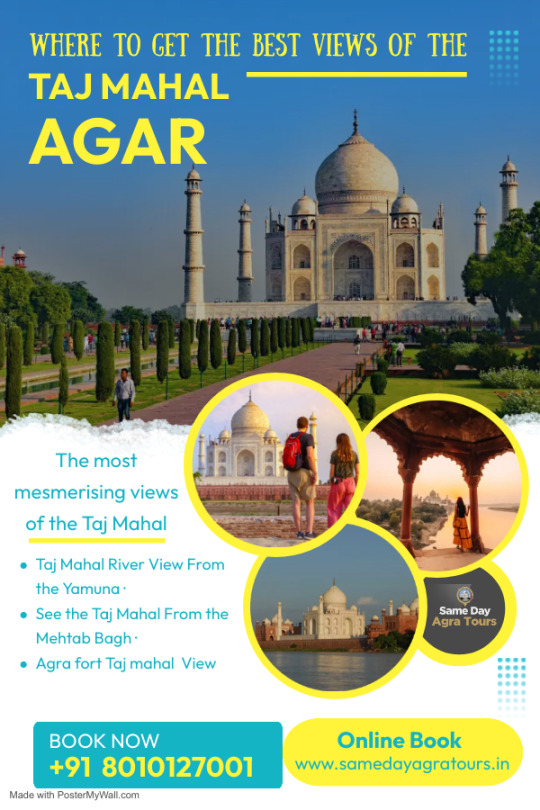
Where to Get the Best Views of the Taj Mahal in Agra, India
Many people have attempted to describe the Taj Mahal's beauty. The architect, Shah Jahan, stated that "it made the sun and the moon shed tears from their eyes." Rudyard Kipling described it as "the embodiment of all that is pure," and Rabindranath Tagore described it as a "teardrop on the cheek of eternity."
Although it may appear that I am exaggerating, if you were to ask me what is the most beautiful building I have ever seen, there is no contest; the Taj Mahal reigns supreme. I'm not alone in this. I'm certain that the over 4 million tourists who pass through the complex's massive red sandstone gates each year to see India's most popular tourist destination would agree with me.
Most visitors are already familiar with the Taj Mahal and its history; built by Shah Jahan in 1631 as a memorial for his third wife, who died in childbirth, the main mausoleum took only 8 years to complete, but the complex as a whole wasn't finished until 1653. As a result, it is frequently referred to as the world's greatest love monument. What most people don't realise is that you don't have to enter the complex to get a good view of the building's gleaming white onion dome.
If you want to see the Taj Mahal from a different perspective, here are my favourite alternative locations to visit.
Suggested tour: Taj Mahal Sunrise Tour, Same Day Agra Tour, Agra Sightseeing Tour, Agra Tour from Delhi
Mehtab Bagh

The Mehtab Bagh gardens on the north bank of the Yamuna river offer one of the most captivating views of the Taj Mahal. Beautiful Mehtab Bagh is a long, rich green lawn filled with floral shrubs that was created to resemble the Taj Mahal's own ornamental gardens. According to legend, Shah Jahan, the Mughal emperor, had long planned to construct a tomb for himself there that would be an identical replica of the Taj, but made completely of black marble. The concept was inspired by the fantastical tales of European traveller Jean-Baptiste Tavernier, who visited Agra in 1665. It was alleged that Shah Jahan's son Aurangzeb overthrew him before the structure could be constructed.
Opening Hours: 6am – 6pm
Entry fee: 100 Rs
Must Read: What Other Attractions in Agra Are the Best for Tourists
From a Boat on the Yamuna River
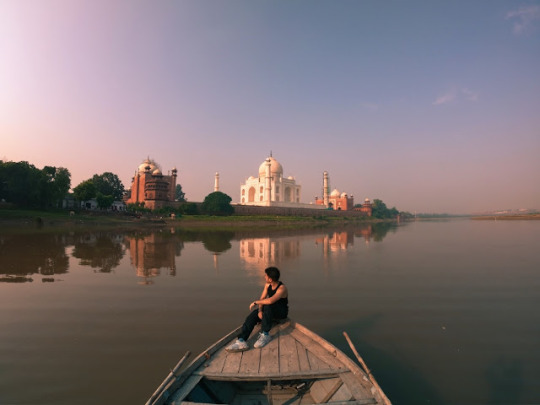
The Taj Mahal is in view as the sun is sinking, a boatman is navigating a wooden boat across the Yamuna, and the enormous white onion dome is reflected in the still waters. This is the scene that you typically see in travel guides or publications. Tourists are not permitted to ride a boat on the Yamuna, according to the law. Nevertheless, this does not imply that it is impossible; all you need to do is know who to ask and where to look. Who, after all, would want to sacrifice the Taj Mahal's best view for the sake of a few rules? Most hostels in and around Agra offer this tour but I found that the best way is to do it yourself from Dusshera ghat. (250 Rs p.p.)
The Trails of The Taj Nature Walk

This verdant parkland area is a short distance from the Taj Mahal via the East Gate Road and is crisscrossed by walking trails, picnic areas, and lookout points. If you're seeking for a little peace & quiet, you can anticipate it to be rather peaceful compared to the rest of Agra because the nature reserve is 70 acres in size and stretches from the road towards the banks of the Yamuna. While I was there, only two other couples were seen strolling the trail
Opening Hours: 7am – 6pm
Entry Fee: 100 Rs. for foreigners, 20 Rs for Indians.
Must Read: Must Visit Attractions around Agra
Agra Fort
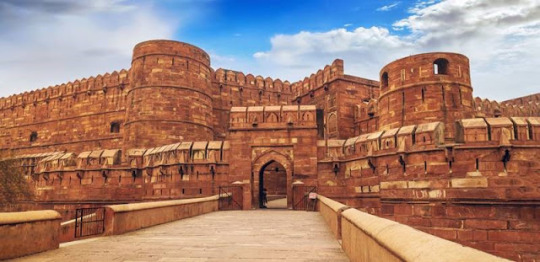
This remnant of the Mughal era made of red sandstone is Agra's most spectacular building except the Taj. Emperor Akbar started building it in 1565 along the Yamuna River's banks, and his grandson Shah Jahan later added white marble decorations. During his rule, what had been a vast military castle was changed into a palace.
The fort's size will be what most impresses you. The walls occasionally reach a height of 20 metres across its 2.5 kilometre diameter. The interior is just as spectacular as the exterior once you enter. The Shish Mahal (mirror palace), Khas Mahal, Diwan-e-khaas (hall of secret hearings), Moti Masjid (pearl mosque), and Nagina Masjid (gem/jewel mosque) are just a few of the magnificent buildings you can find here. To get the most out of your visit, my recommendation is to meander around the numerous buildings for a whole morning or afternoon.
Opening Hours: 7am – 6pm
Entry Fee: 100 Rs. for foreigners, 20 Rs for Indians
Chhatris by the Yamuna River- The Secret Taj Mahal Sunset Point

Possibly my favourite off-beat place to photograph the Taj Mahal from, this chhatri (dome shaped pavilion) by the Yamuna river is a must-visit monument in Agra. It is located just a short walk away from the East Gate entrance of the Taj, though getting there can be a bit tricky if you are alone and do not know where to go.
To reach this secret Taj Mahal sunset point, walk towards the direction of Dusshera Ghat on Dusshera Ghat Road from the East Gate entrance of the Taj. The perimeter wall of the Taj will be on your left as you make your way to the riverbank. Now, instead of going straight to the Ghat, take the first right (there is a small diversion so try not to miss it) to continue onto Dusshera Ghat Road.
#Where to Get the Best Views of the Taj Mahal in Agra#India#7 Best Taj Mahal View Point Locations in Agra#Where to Find the Best Views of the Taj Mahal in Agra#12 Best Taj Mahal Viewpoints in Agra#Taj Mahal View Point (Agra)#Best Views of the Taj Mahal
3 notes
·
View notes
Text
Sept 27, 2022: Campagnano di Roma to La Storta - 25.4 km; CUS - 1,800 ft
403.2 km to date
Memories of India
The British tour group tracked in about an hour and a half after us, but still game after a very long, wet day. On our way out to explore and whine/wine about 5 pm we encountered the guides and the last two ladies to come in, including one who had been sidelined with really bad blisters but came back today and made the whole distance. My admiration for them continues. I have been fortunate not to have any blisters this trip, a first on these long treks with Kim (he never seems to get them). Less fortunately, I stepped in a puddle on the street today that turned out to be a couple of missing cobble stones. I badly reinjured my calf and right hip and i am walking with a pronounced limp while trying to avoid walking at all. I was still able to finish today and tomorrow should be a cakewalk to St Peters.
Dinner last night was fabulous. Kim and I both had the bruschetta fantasia (1 artichoke, 1 pomodoro and one capicollo plus a pot of hot beans and crostini. Then Kim had the gnocchi with an arugula pesto and cherry tomatoes while I had the bucatini amatriciana. Both were perfect, as was the house red. Filled with locals, eccentrically decorated and run by three generations of family, I just thought it was something my brother would have loved. Throughout we were entertained by the owners 16ish month old grandson running around the tables chasing and being chased by grandpa. Made me homesick for the grandkids. Normally the food is included in our half board but we pay for wine and mineral water. Nonetheless, the owner refused payment of any kind. So saying, I gave him 10€ and told him in broken Italian to buy something for the little guy. In response, I was gifted with a huge smile and a grazie mille.
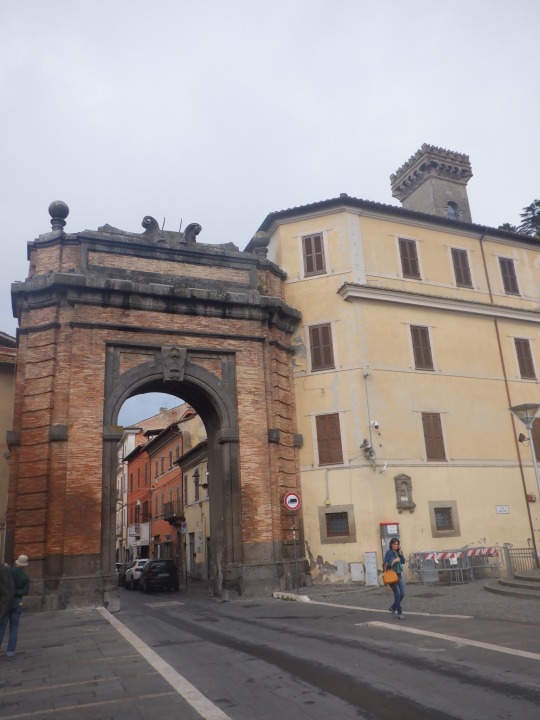

Today basically a long, tough, boring trudge. The hi-lite of the day was running into a number of cows on the loose and a older woman in her little Fiat Panda desperately looking for them. We found two at a roadside and one immediately started meandering toward me with a determined look on its face (do cows have looks or just vacant stares?) It reminded me of walking down a road in India (where cows are as ubiquitous as boulevard trees) and encountering several cows, one of which seemed determined to make Luanne her friend and followed her for a considerable distance.

Other than that, the most interesting thing today was a sign explaining that we had just walked over a subterranean aqueduct about 100 sq feet in cross section. It was apparently 78 km long with a consistent 1.2-2% slope. It was built by the Etruscans to bring water from mountains to the city of Veio. Needless to say I have no pictures to share. Instead, I offer pictures of an old mill (below are the millstones) and 60-80 foot waterfall we passed. I regret to say that after about 20 km walking there was no way I was scrambling down a cliff and back up to get a better picture from the bottom.

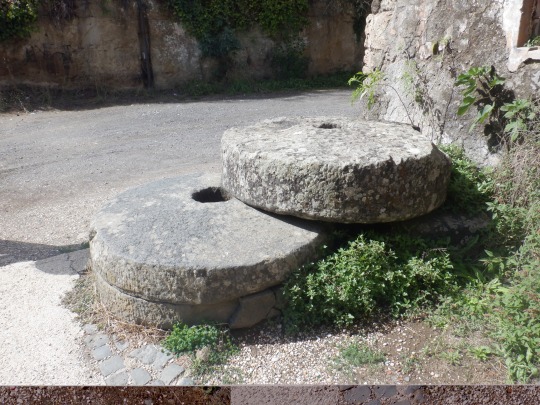
We arrived about 3:30, had a glass of wine and showered and are still awaiting the arrival of our British friends.
Random Thoughts
Umbrella Pines
As we were walking yesterday, I got to thinking about how, for many people, rows of cypress trees lining a road through a hillside vineyard is symbolic of the Tuscan countryside. Kim, on the other hand, is absolutely enamoured with the Plane Trees, many of which are centuries old. My favourite is the umbrella pines, tall with the characteristic crown and all the dead lower limbs removed, this is Tuscany to me.
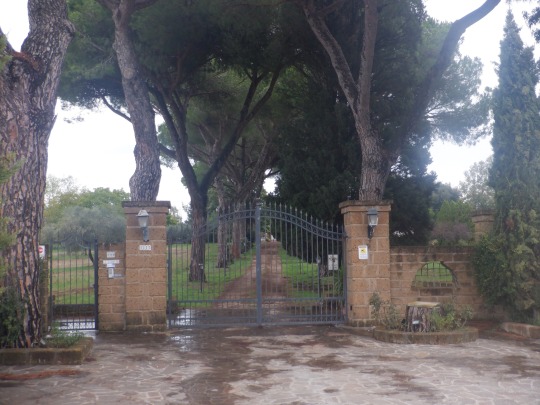
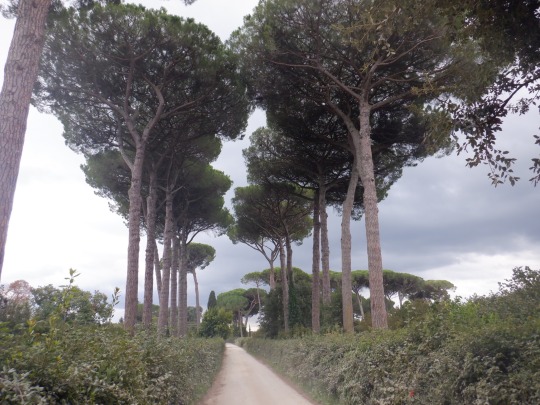
Italian Clocks
Time seems unimportant when you are walking through the Italian countryside. This is reinforced by the fact that every little town has a clock tower, sometimes on the city gate, sometime on a church bell tower and sometimes on city hall. Why does this support the idea that time is unimportant? It is because none of them tell the correct time. We even found one where the wrong time is different on different sides of the clock tower, all different, but all wrong.
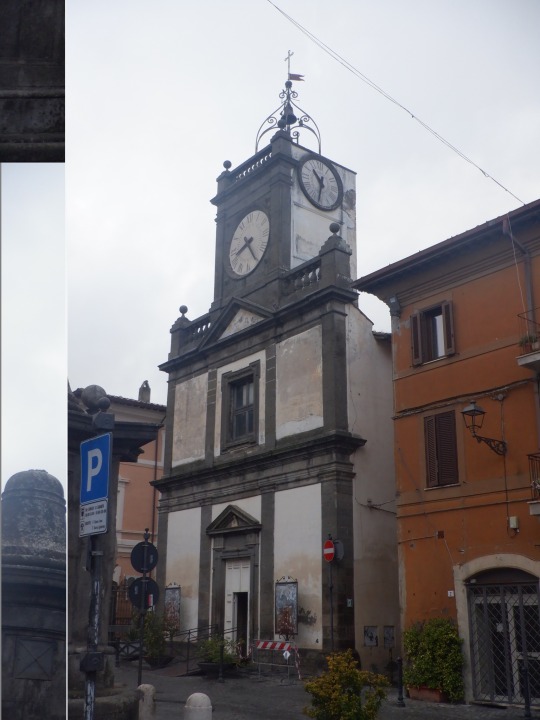
2 notes
·
View notes
Text
One Day Private Old and New Delhi Tour By Taj Mirror Company

One Day Private Old and New Delhi Tour by Taj Mirror Company
Delhi, the busy capital of India, presents a captivating blend of the ancient and the modern. From the medieval alleys of Old Delhi to the vast, tree-lined avenues of New Delhi, the city delivers a kaleidoscope of experiences that enchant every traveler. The One Day Private Old and New Delhi Tour by Taj Mirror Company is designed to provide a full perspective of this wonderful metropolis, taking you through its rich history, culture, and active urban life.
H1: Overview of the One Day Private Old and New Delhi Tour
This one-day private tour offers an opportunity to discover both the historic and contemporary sides of Delhi with the convenience of a private car and an expert guide. Whether you are a history buff, a culture enthusiast, or simply an inquisitive visitor, this tour provides a full experience of the varied highlights that Delhi has to offer.
H2: Highlights of the Tour
Comprehensive exploration of Old and New Delhi in one day
Private transportation and a knowledgeable local guide
Visits to prominent sights like as Jama Masjid, Red Fort, India Gate, and Lotus Temple
A taste of local cuisine at a classic Delhi restaurant
Flexible and personalized itinerary
H2: Itinerary of the One Day Private Old and New Delhi Tour
H3: 9:00 AM - Pickup from Your Hotel
The journey starts with an early pickup from your hotel in Delhi. Taj Mirror Company assures that you travel in the comfort of a private air-conditioned car, with a skilled driver and a trained guide to accompany you throughout the day. After a quick introduction to the day's schedule, the experience begins with a dive into the historic center of Delhi.
H3: 9:30 AM - Explore Old Delhi
The first section of the journey concentrates on Old Delhi, a region steeped in history and alive with the chaotic charm of India’s past. Here, you’ll explore the Jama Masjid, one of the greatest mosques in India, which was erected by Mughal Emperor Shah Jahan. This majestic structure offers breathtaking views of the city from its minarets. Next, you'll take a rickshaw ride through the bustling lanes of Chandni Chowk, the oldest and busiest market in Delhi, where you can observe the lively energy of local life.
H3: 11:00 AM - Visit the Red Fort
No journey to Old Delhi is complete without a visit to the renowned Red Fort. This UNESCO World legacy monument stands as a symbol of India’s rich Mughal legacy and was originally the royal home of the Mughal rulers. Your guide will lead you through the spectacular fort, revealing stories of its grandeur, architecture, and historical importance.
H3: 12:30 PM - Lunch Break
After a hectic morning, you’ll take a break to eat a typical Indian lunch at a local restaurant. Taj Mirror Company will recommend some of the best venues to partake in Delhi’s famous street cuisine or a full-course meal comprising North Indian classics like butter chicken, naan, and dal makhani.
H3: 1:30 PM - Drive to New Delhi
Post-lunch, the tour switches to New Delhi, where vast boulevards, colonial-era architecture, and modern landmarks form a stark contrast to the small passageways of Old Delhi. You’ll travel by the Rajpath, a ceremonial boulevard that leads to the India Gate, a military memorial dedicated to Indian soldiers who died in World military I.
H3: 2:00 PM - Visit India Gate and President’s House
Your next stop is India Gate, one of New Delhi’s most iconic monuments. Standing towering and imposing, the India Gate remembers the men who laid down their lives during the First World War. Nearby, you’ll also get a view of Rashtrapati Bhavan, the official residence of the President of India. Your guide will explain the significance of this enormous structure, which was previously the Viceroy's House during British administration.
H3: 3:00 PM - Lotus Temple
The journey continues with a visit to the Lotus Temple, a magnificent Bahá'í House of Worship fashioned like a lotus blossom. Known for its modern construction and soothing atmosphere, this temple is open to individuals of all religions and offers a peaceful space for silent thought.
H3: 4:00 PM - Qutub Minar
Next, you’ll see the majestic Qutub Minar, another UNESCO World Heritage site. This tower, erected in the 12th century, stands as the tallest brick minaret in the world and is surrounded by an assortment of historic structures. Your guide will discuss the intriguing history of this architectural masterpiece, which is considered one of the finest examples of Indo-Islamic architecture.
H3: 5:30 PM - Humayun’s Tomb
Your final visit for the day is Humayun’s Tomb, the first garden-tomb in India and a predecessor to the Taj Mahal. Built in the mid-16th century, this enormous building is the ultimate resting place of Emperor Humayun and remains as a tribute to Mughal design. The verdant grounds and stunning buildings provide a relaxing finale to your day of sightseeing.
H3: 6:30 PM - Return to Your Hotel
After a long day of exploration, you’ll be taken back to your accommodation in the evening. The memories of Delhi’s rich history, busy markets, and breathtaking architecture will undoubtedly stay with you long after your adventure ends.
H2: Why Choose the One Day Private Old and New Delhi Tour?
This customized trip is great for those with limited time who want to explore the best of both Old and New Delhi. Taj Mirror Company ensures that you enjoy a personalized experience, allowing flexibility in the schedule to fit your hobbies and tastes. With a professional guide, comfortable transportation, and a carefully prepared schedule, you can visit the highlights of Delhi in just one day without feeling rushed.
H2: Benefits of the Tour
Personalized Experience: A private guide and car allow you to customize your day based on your interests and pace.
Expert Guidance: Learn about the history, architecture, and culture of Delhi from a qualified local guide.
Convenience: Travel comfortably in a private automobile, eliminating the inconvenience of public transport and long delays.
Comprehensive Itinerary: Experience both the ancient and modern parts of Delhi in one day, visiting the city’s greatest sites.
H2: Conclusion
The One Day Private Old and New Delhi Tour by Taj Mirror Company offers an immersive and easy way to discover the best of Delhi in just a single day. From the rich history of Old Delhi’s Mughal architecture to the modern grandeur of New Delhi’s landmarks, this tour gives a well-rounded experience that shows the city’s diversity and appeal. Whether you’re a first-time visitor or someone eager to revisit Delhi, this tour is the perfect introduction to India’s lively city.
FAQs Q1: What time does the tour start?
The tour normally starts at 9:00 AM with a pickup from your hotel.
Q2: Is lunch included in the trip package?
Lunch is not included, however your guide will recommend some good local eateries where you may have a typical Indian meal.
Q3: Can the itinerary be customized?
Yes, Taj Mirror Company gives flexibility in the schedule, allowing you to omit or add particular sites based on your interests.
Q4: How long does the tour last?
The tour lasts around 8–9 hours, covering the key sights of both Old and New Delhi.
Q5: Is there a clothing code for visiting religious sites?
Yes, modest dress is suggested, and you may be requested to remove your shoes while entering sacred locations like the Jama Masjid.
0 notes
Text
Delhi one day tour package by bus

A Delhi one day tour package by bus offers an exciting way to explore the city's top attractions in a single day. Ideal for groups, the tour covers iconic landmarks such as India Gate, Qutub Minar, Lotus Temple and Red Fort. The journey starts early in the morning, with the bus picking you up from a designated location and guiding you through the rich history and culture of Delhi.
This tour is perfect for families, tourists and school groups who want to experience the capital city without worrying about navigating public transport. The itinerary typically includes breaks for meals at popular local restaurants, allowing you to savor Delhi's culinary delights while sightseeing.
Booking a 25-seater mini bus for the tour is a smart choice for larger groups, offering a comfortable and hassle-free experience. The 25 Seater Mini Bus Price usually ranges from ₹8,000 to ₹12,000 per day, depending on the season and the amenities provided. It's a budget-friendly and efficient way to enjoy a memorable day out in Delhi.
0 notes
Text

India Gate tour guide is the best monument to visit in Delhi. It is a majestic war memorial located in the heart of New Delhi, India. Standing tall at 42 meters, it was built to commemorate the 70,000 Indian soldiers who died fighting for the British Army during World War I and the Third Anglo-Afghan War.
0 notes
Text
Golden Triangle Tour with Ranthambore By Taj Explorers Company

Explore India’s Heritage and Wildlife: Golden Triangle Tour with Ranthambore by Taj Explorers Company
India’s Golden Triangle Tour is already a spectacular experience, uniting three great cities—Delhi, Agra, and Jaipur. But if you’re a wildlife fanatic or searching for something more adventurous, the Golden Triangle Tour with Ranthambore is the perfect extension to your travel schedule. This journey mixes India’s rich cultural past with the thrill of a safari at Ranthambore National Park, one of India’s premier sites for spotting tigers in the wild.
The Golden Triangle with Ranthambore Tour given by Taj Explorers Company assures you don’t just explore the stunning architectural marvels but also immerse into the raw wilderness of India. Let’s take a deeper look at this 6-day vacation that integrates history, culture, and wildlife experience.
Why Choose the Golden Triangle Tour with Ranthambore?
The Golden Triangle Tour is already a great way to visit India’s top locations. However, the presence of Ranthambore takes the experience to the next level. It gives an exhilarating escape from city exploring with an opportunity to witness India’s wildlife, including the renowned Bengal tiger, in its native habitat.
With Taj Explorers Company, you’ll have a meticulously designed tour that not only covers the highlights of Delhi, Agra, and Jaipur but also includes a thrilling safari experience in Ranthambore National Park. Here’s what makes this tour unique:
Cultural and Wildlife Blend: From iconic sights like the Taj Mahal to tracking tigers in the wild, this journey offers a healthy blend of both worlds.
Expert Guides: Taj Explorers provides skilled guides that offer deep insights into the history, culture, and wildlife of each area.
Comfortable and Safe Travel: Enjoy private, air-conditioned transport and carefully selected hotels for a smooth and comfortable journey.
Itinerary for the Golden Triangle Tour with Ranthambore
Here’s a breakdown of the day-by-day agenda for this thrilling 6-day tour:
Day 1: Arrival in Delhi and City Exploration
Your tour begins in Delhi, India’s colorful capital. Upon arrival, you’ll be greeted by a representative from Taj Explorers Company and taken on a guided tour of Old and New Delhi.
Red Fort: Explore the majesty of the Red Fort, a UNESCO World Heritage Site and a symbol of India’s Mughal past.
Jama Masjid: Visit India’s largest mosque, Jama Masjid, with its breathtaking architecture and tranquil ambiance.
India Gate: Pay a visit to the India Gate, a war memorial honoring Indian soldiers.
Qutub Minar: Admire the towering Qutub Minar, another UNESCO-listed landmark, famed for its beautiful carvings and historical significance.
After a day of sightseeing, you’ll head to your hotel in Delhi for a restful night’s relaxation.
Day 2: Delhi to Agra - The City of the Taj Mahal
On day two, you’ll head to Agra, home of the world-famous Taj Mahal.
Taj Mahal: Begin your day with a visit to the Taj Mahal, one of the Seven Wonders of the World. The white marble tomb, erected by Emperor Shah Jahan, is a symbol of love and an architectural wonder.
Agra Fort: Explore the spectacular Agra Fort, another UNESCO landmark that originally served as the Mughal rulers' palace.
After exploring Agra’s architectural marvels, you'll check into your hotel for the night.
Day 3: Agra to Ranthambore via Fatehpur Sikri
On day three, you’ll continue your trek to Ranthambore, with a stop in Fatehpur Sikri.
Fatehpur Sikri: This abandoned Mughal city, now a UNESCO World Heritage Site, is packed with spectacular palaces and mosques, representing the grandeur of the Mughal Empire.
After your visit to Fatehpur Sikri, you’ll head to Ranthambore National Park. Check into your jungle lodge and unwind, preparing for the animal adventure that awaits.
Day 4: Ranthambore National Park - Jungle Safari
The fourth day is dedicated to a fantastic wildlife safari in Ranthambore National Park.
Morning Safari: Wake up early for a morning safari, the greatest time to observe the elusive Bengal tigers. Keep your camera ready as you may also encounter other wildlife like leopards, deer, sloth bears, and numerous bird species.
nighttime Safari: After some rest, you’ll head out for a nighttime safari, enhancing your chances of spotting the park's rich animals and enjoying the stunning natural surroundings.
Ranthambore offers more than simply tigers; it’s a sanctuary for photographers and environment enthusiasts, with lush foliage, historic ruins, and calm lakes.
Day 5: Ranthambore to Jaipur - The Pink City
After an amazing stay in Ranthambore, your journey continues to Jaipur, widely known as the Pink City. Upon arrival, you’ll explore some of the city’s most iconic landmarks.
Amber Fort: A beautiful hilltop fort noted for its stunning blend of Hindu and Mughal architecture, complete with the renowned Sheesh Mahal (Hall of Mirrors).
Hawa Mahal: Also known as the Palace of Winds, this landmark monument is notable for its ornate pink façade and lattice windows.
City Palace: A palace complex in the heart of Jaipur, the City Palace is home to museums, courtyards, and royal treasures.
After a day of royal exploration, you’ll stay overnight in Jaipur.
Day 6: Return to Delhi
On the final day, you’ll begin your return journey to Delhi. Depending on your flight itinerary, you may have time for some last-minute shopping or a visit to any remaining landmarks in Jaipur. The tour closes with a drop-off at your hotel or the airport in Delhi, bringing your Golden Triangle with Ranthambore adventure to an end.
Why the Golden Triangle with Ranthambore Tour Stands Out
This journey delivers a unique combination of cultural exploration and animal adventure, making it ideal for those seeking both history and natural beauty. While you marvel at the architectural wonders of the Taj Mahal and Amber Fort, you’ll also experience the excitement of a safari in Ranthambore National Park, one of the best sites in India to observe wild tigers.
Conclusion
The Golden Triangle Tour with Ranthambore by Taj Explorers Company is a unique blend of cultural heritage and wildlife experience. With a well-structured itinerary, skilled instructors, and comfortable travel accommodations, this tour assures you get the best of both worlds. Whether you’re a history buff or a nature enthusiast, this voyage will leave you with wonderful memories of India.
FAQs 1. What is included in the Golden Triangle with Ranthambore Tour?
This itinerary includes excursions to Delhi, Agra, Jaipur, and a safari experience in Ranthambore National Park.
2. How long is the tour?
The tour includes 6 days, delivering a well-rounded experience of both culture and nature.
3. Is the safari safe?
Yes, the safaris in Ranthambore National Park are conducted by trained guides, and safety procedures are always in place.
4. When is the best time to visit Ranthambore?
The greatest period for tiger sightings is between October and April when the weather is favorable and the possibilities of viewing wildlife are higher.
5. Can I modify the tour?
Yes, Taj Explorers Company offers flexibility in their itineraries, allowing you to tailor the journey according to your tastes.
0 notes
Text
Full Day Old and New Delhi Tour By Private Taj Mahal Tour Company

Full Day Old and New Delhi Tour by Private Taj Mahal Tour Company
Delhi, the hub of India, is a city steeped in history, culture, and modernity. A Full Day Old and New Delhi Tour by the Private Taj Mahal Tour Company allows you the chance to discover both the ancient and modern elements of this lively metropolis. This thorough tour includes Delhi’s most prominent landmarks, from the lively streets of Old Delhi to the elegant avenues of New Delhi. With skilled guides, luxurious transport, and a well-planned schedule, this tour ensures an amazing experience of India’s capital.
H1: Why Take a Full Day Tour of Old and New Delhi?
Delhi’s blend of historical landmarks and modern infrastructure makes it one of the most diversified cities in India. The Full Day Old and New Delhi Tour gives you the opportunity to explore:
Old Delhi’s Charm: Dive into the small, bustling lanes and vivid bazaars that symbolize the city’s ancient Mughal past.
New Delhi’s Elegance: Discover the architectural marvels and huge boulevards created by the British during the colonial era, along with some modern icons.
Whether you’re a history enthusiast or a visitor seeking real experiences, this tour delivers a well-rounded insight of Delhi’s dual personality.
H2: Highlights of the Full Day Delhi Tour
Booking the Old and New Delhi Tour with the Private Taj Mahal Tour Company means you’ll have access to the finest sights, expert advice, and customized service. Let’s take a closer look at the tour highlights:
H3: Pickup from Your Hotel
Your day begins with a comfortable pickup from your accommodation in a private, air-conditioned vehicle. The Private Taj Mahal journey Company offers door-to-door service, ensuring you start your journey stress-free. Your cheerful, professional guide will meet you and provide an outline of the day’s agenda.
H2: Exploring Old Delhi
H3: Red Fort (Lal Qila)
Your first stop is the magnificent Red Fort, a UNESCO World Heritage Site and a symbol of India’s rich past. Built by Emperor Shah Jahan in 1638, the fort is a spectacular example of Mughal architecture, with towering red sandstone walls that still stand tall today. You’ll visit the fort’s courtyards, palaces, and museums while learning about the grandeur of the Mughal Empire from your guide.
H3: Jama Masjid
Next, you’ll visit Jama Masjid, India’s largest mosque. This awe-inspiring building was also built by Shah Jahan and can hold up to 25,000 worshippers. The mosque’s exquisite design, with its enormous domes and minarets, presents a tranquil contrast to the bustling streets of Old Delhi. You can even climb the minaret for panoramic views of the city.
H3: Chandni Chowk Market
After viewing the historical landmarks, descend into the busy yet charming lanes of Chandni Chowk, one of Delhi’s oldest and busiest markets. Here, you can experience the authentic essence of Old Delhi, with traders selling everything from spices and sweets to textiles and jewelry. Your guide will take you on a rickshaw ride through the tight lanes, delivering an exciting and authentic view of this busy bazaar.
H3: Raj Ghat (Mahatma Gandhi Memorial)
The group next goes to Raj Ghat, a simple yet emotional memorial dedicated to Mahatma Gandhi, the Father of the Nation. This tranquil site symbolizes the place where Gandhi was cremated after his assassination in 1948. The perpetual flame at the memorial and the quiet garden setting give a moment of introspection amidst the hectic city.
H2: Discovering New Delhi
After the hectic streets of Old Delhi, you’ll go to the more spacious and modern side of the city, New Delhi.
H3: India Gate
The first stop in New Delhi is the magnificent India Gate, a war memorial built to memorialize Indian soldiers who perished in World War I. Surrounded by verdant grass, this majestic archway is a popular site for both tourists and locals. Your guide will highlight the historical significance of this landmark while you take in its majestic beauty.
H3: Rashtrapati Bhavan (Presidential Residence)
Next, you’ll drive past the majestic Rashtrapati Bhavan, the official residence of the President of India. This majestic edifice is a fine example of colonial architecture and situated at the end of Rajpath, the ceremonial boulevard that connects it to India Gate. The huge Mughal Gardens around the palace are also a delight to behold.
H3: Humayun’s Tomb
Another UNESCO World Heritage Site on the agenda is Humayun’s Tomb, a forerunner to the Taj Mahal. This beautiful 16th-century mausoleum, erected for the Mughal Emperor Humayun, is an outstanding combination of Persian and Indian design. The wonderfully groomed grounds and elaborate workmanship of the mausoleum make it one of Delhi’s most attractive historical attractions.
H3: Qutub Minar
The final significant visit of the day is the towering Qutub Minar, the tallest brick minaret in the world and again another UNESCO World Heritage Site. Built in 1193, this 73-meter-high building is a masterpiece of Islamic design. The neighboring Qutub complex is similarly impressive, including old ruins and beautiful carvings that recount the narrative of Delhi’s early Islamic kings.
H2: Local Cuisine and Markets
Throughout the day, you’ll also get the opportunity to enjoy Delhi’s culinary delights:
H3: Traditional Indian Lunch
During your tour, have a typical Indian lunch at a local restaurant. Whether it’s classic North Indian cuisine like butter chicken and naan or vegetarian delicacies like dal makhani and paneer tikka, the flavors of Delhi will leave you wanting more.
H3: Shopping in New Delhi
If time allows, you may also explore some of New Delhi’s posh markets, such as Connaught Place or Dilli Haat, where you can shop for handicrafts, souvenirs, and local fabrics.
H2: Return to Your Hotel
After a long day of experiencing Delhi’s treasures, your private driver will take you back to your accommodation. The Private Taj Mahal Tour Company ensures that your travel is as comfortable as possible, leaving you with fond recollections of India’s capital.
H2: Why Choose the Private Taj Mahal Tour Company?
Booking your Full Day Old and New Delhi Tour with the Private Taj Mahal Tour Company offers various advantages:
Personalized Service: Enjoy a private tour tailored to your tastes, with expert guides and flexible schedule.
Seamless Experience: From hotel pickup to drop-off, every detail is taken care of, so you can rest and enjoy the day.
Expert Local Guides: Your guide’s understanding of Delhi’s history and culture will improve your experience, bringing the city’s landmarks to life.
H1: Conclusion
A Full Day Old and New Delhi Tour by the Private Taj Mahal Tour Company is the perfect opportunity to see the rich history and lively culture of India’s capital. From the bustling streets of Old Delhi to the vast avenues of New Delhi, this trip offers a comprehensive look at the city’s most prominent landmarks. Whether you’re a first-time visitor or returning to delve further into Delhi’s legacy, this tour promises a day full of exploration, beauty, and amazing encounters.
FAQs Q1: How long is the Full Day Old and New Delhi Tour?
A: The tour normally lasts between 8 to 10 hours, depending on traffic and the time spent at each stop.
Q2: Is lunch included in the tour?
A: Yes, a typical Indian lunch is offered at a local restaurant throughout the tour.
Q3: Can I alter the travel itinerary?
A: Absolutely! The Private Taj Mahal Tour Company offers customizable itineraries, so you may personalize the tour to include specific places or activities.
Q4: How can I book the Full Day Delhi Tour?
A: You can book the tour online through the Private Taj Mahal Tour Company’s website or call their customer service for additional details.
Q5: Are entry costs to monuments included?
A: Entry costs to prominent landmarks like the Red Fort, Humayun’s Tomb, and Qutub Minar are often included in the tour package.
0 notes
Text
Golden Triangle Tour 3 Nights and 4 Days from Delhi

Embark on an unforgettable journey through India's most iconic landmarks with the Golden Triangle Tour 3 nights 4 days. This 3 night 4 days tour from Delhi covers the majestic cities of Delhi, Agra, and Jaipur, giving tourists a glimpse into India’s rich history, architectural brilliance, and numerous lifestyles.
The Golden Triangle is one of the most famous tourist circuits in India, offering the precise combo of journey, subculture, and luxury for each home and international travelers.
Why Choose the 3 Nights 4 Days Golden Triangle Tour?
The Golden Triangle Tour is ideal for those trying to experience the essence of India in a quick time. Here's why it’s a need to:
A Perfect Mix of History and Culture: You get to discover the Mughal heritage in Delhi and Agra, and the royal grandeur of Jaipur, a multi-function journey.
Time-Efficient: In simply 4 days, you could visit a number of India’s most renowned sites without the need for an extended holiday.
Ideal for All Travelers: Whether you are a solo traveller, a couple, or a own family, this tour is ideal for all of us searching for a compact but immersive revel in of India.
Day 1: Arrival in Delhi and Exploring the Capital
Your adventure starts inside the bustling city of Delhi, the coronary heart of India. Upon arrival, you will be greeted and transferred in your inn. After a brief rest, you will embark on a excursion of some of Delhi’s most iconic landmarks.
India Gate: A majestic conflict memorial, India Gate stands as a tribute to the infantrymen who laid down their lives during World War I.
Qutub Minar: The tallest brick minaret in the world and a UNESCO World Heritage Site, showcasing a complex Mughal structure.
Humayun's Tomb: Another UNESCO World Heritage Site, this stunning shape is the precursor to the Taj Mahal and displays the early Mughal architecture.
In the night, enjoy a leisurely stroll via the bustling markets of Old Delhi or bask in some local cuisine at a conventional restaurant. After an exciting day, retire for your resort for a snug night’s live.
Day 2: Delhi to Agra – The City of Love
After breakfast, you'll start your power to Agra, a city that homes one of the Seven Wonders of the World. The pressure takes approximately 3-4 hours alongside the scenic Yamuna Expressway.
Upon arrival in Agra, your first forestall is the Taj Mahal, a UNESCO World Heritage Site and the remaining image of eternal love. Built by Mughal Emperor Shah Jahan in reminiscence of his spouse Mumtaz Mahal, this marble mausoleum is renowned for its breathtaking beauty and intricate craftsmanship.
A guided tour of the Taj Mahal will display the story in the back of its production, and you will have sufficient time to explore the grounds, take photographs, and immerse yourself in the serene ecosystem of this architectural marvel.
Agra Fort – A Glimpse of Mughal Grandeur
Next, go to the Agra Fort, another UNESCO World Heritage Site. This huge purple sandstone fort served as the house of the Mughal emperors. Explore its various palaces, mosques, and halls, which includes Diwan-i-Aam (Hall of Public Audience) and Diwan-i-Khas (Hall of Private Audience).
After a day of exploration, enjoy dinner at a neighborhood eating place and head again to your lodge for a restful night time.
Day 3: Agra to Jaipur – The Pink City
On the 3rd day of your tour, you will drive to Jaipur, the capital city of Rajasthan, additionally referred to as the Pink City. En direction, prevent at Fatehpur Sikri, a deserted Mughal metropolis that changed into the capital of Emperor Akbar.
Explore the Buland Darwaza, the largest gateway inside the world, and different architectural wonders including the Panch Mahal and Jama Masjid.
After exploring Fatehpur Sikri, retain your journey to Jaipur, which takes approximately 4-5 hours. Upon arrival, take a look at your hotel and spend the night at enjoyment. You can discover Jaipur’s vibrant local markets, which are well-known for textiles, jewellery, and handicrafts.
Day 4: Jaipur – The Royal Heritage
Start your day with a visit to the majestic Amber Fort, placed simply outside Jaipur. This hilltop citadel, constructed with red sandstone and marble, offers a stunning view of the encircling hills and Maota Lake. Inside the citadel, explore its royal courtyards, palaces, and the famous Sheesh Mahal (Mirror Palace), which is famend for its complex reflect paintings.
City Palace and Jantar Mantar
Next, visit the City Palace, a stunning complex that showcases a blend of Mughal and Rajasthani architectural styles. The palace remains home to the royal circle of relatives of Jaipur and houses a museum that presentations royal costumes, weapons, and artifacts.
Afterward, forestall with the aid of the Jantar Mantar, an astronomical observatory and UNESCO World Heritage Site. This unique website capabilities numerous big gadgets used to degree time and study celestial our bodies.
Hawa Mahal – The Palace of Winds
Conclude your Jaipur exploration with a go to to the Hawa Mahal (Palace of Winds). This 5-tale palace is famous for its lattice home windows, which allowed royal ladies to take a look at avenue festivals with out being seen. The Hawa Mahal’s lovely façade is one of the most photographed landmarks in Jaipur.
After a complete day of sightseeing, you will power returned to Delhi, in which your Golden Triangle Tour comes to an give up.
Conclusion: A Journey Through India’s Golden Heritage
4 days golden triangle tour from Delhi offers an extraordinary journey through India’s wealthy history, subculture, and structure. From the Mughal grandeur of Delhi and Agra to the royal background of Jaipur, this tour provides an unforgettable enjoy for all travelers.
Whether you’re a first-time visitor or a seasoned vacationer, the Golden Triangle is a must visit that showcases the fine of India’s vibrant past and present.
#golden triangle#golden triangle tour#golden triangle tour package#india tour#india tourismn triangle tour\
0 notes
Text
Exploring The 3 Days Golden Triangle Tour: A Tourist's Guide

India is a land of rich cultural heritage, fascinating history, and breathtaking landscapes. Among its countless destinations, the Golden Triangle Tour stands out as one of the most popular tourist circuits. Covering the iconic cities of Delhi, Agra, and Jaipur, this tour offers a glimpse into India's royal past, architectural marvels, and vibrant traditions. If you’re pressed for time, a 3 Days Golden Triangle Tour can provide an unforgettable experience.
In this guide, we’ll walk you through everything you need to know to make the most of your Golden Triangle tour in three days.
Why Choose the 3 Days Golden Triangle Tour?
The Golden Triangle refers to the geographical arrangement of Delhi, Agra, and Jaipur, which form a triangular shape on the map of northern India. Each city is about 200–250 km from the others, making it possible to visit the key landmarks of all three within a short span of time.
A 3 Days Golden Triangle Tour is ideal for travelers who want to:
Experience the best of Indian history and culture in a short duration.
Visit UNESCO World Heritage sites like the Taj Mahal, Agra Fort, and Qutub Minar.
Explore the royal palaces of Jaipur, also known as the Pink City.
Take a deep dive into India's architectural brilliance, with styles ranging from Mughal to Rajputana.
Day 1: Delhi - The Capital City
Morning: Arrival in Delhi & City Exploration
Your Golden Triangle Tour begins in Delhi, the bustling capital city that offers a blend of ancient and modern attractions. Start your day early and head to explore Old Delhi, where you'll find landmarks that reflect India's rich Mughal history.
Red Fort – A UNESCO World Heritage Site, this red sandstone fort served as the residence of Mughal emperors. Its impressive architecture and grandeur will leave you in awe.
Jama Masjid – One of the largest mosques in India, Jama Masjid offers breathtaking views of Old Delhi from its towering minarets.
Afternoon: New Delhi Landmarks
After exploring the charm of Old Delhi, it's time to move to New Delhi, the modern and well-planned part of the city. You can visit:
India Gate – A war memorial built in honor of Indian soldiers who fought in World War I. The India Gate is a great place for a leisurely stroll.
Rashtrapati Bhavan – The official residence of the President of India, Rashtrapati Bhavan is an architectural masterpiece. Though entry is restricted, you can view it from outside.
Qutub Minar – Another UNESCO World Heritage Site, this towering minaret is one of the finest examples of Indo-Islamic architecture.
Evening: Drive to Agra (Approx. 4 hours)
In the evening, start your drive to Agra, the second city of the Golden Triangle. Upon arrival, check into your hotel and relax, preparing for the next day’s adventure. You can also take a night view of the Taj Mahal, as it looks stunning under the moonlight.
Day 2: Agra - The City of the Taj Mahal
Morning: Visit the Taj Mahal
Begin your day with a sunrise visit to the Taj Mahal, one of the Seven Wonders of the World. The morning light casts a magical glow on this white marble mausoleum, making it one of the best times to visit. Commissioned by Shah Jahan in memory of his beloved wife Mumtaz Mahal, the Taj Mahal is a symbol of eternal love and an architectural marvel.
Spend time admiring its intricate details, the gardens, and the reflecting pools. Make sure to capture photos from various angles to fully appreciate its beauty.
Mid-Morning: Agra Fort
Just a few kilometers from the Taj Mahal lies the Agra Fort, a UNESCO World Heritage Site and another architectural masterpiece from the Mughal era. Built by Emperor Akbar, this fort is a walled city with palaces, halls, and gardens. The Diwan-i-Khas and Diwan-i-Aam are must-visit halls within the fort.
Afternoon: Drive to Jaipur (Approx. 5 hours)
Post lunch, it's time to hit the road and head to Jaipur, the third city in your Golden Triangle Tour. En route, you can stop at Fatehpur Sikri, a historical city founded by Emperor Akbar. The city’s architectural grandeur and fascinating history make it a great stop for history enthusiasts.
Upon reaching Jaipur, check into your hotel for a comfortable night’s stay.
Day 3: Jaipur - The Pink City
Morning: Explore Jaipur's Royal Heritage
Start your day in Jaipur, famously known as the Pink City due to the pink hue of its buildings. Jaipur is renowned for its palaces, forts, and vibrant bazaars. Begin your exploration with a visit to:
Amber Fort – Located on a hill, the Amber Fort is a majestic palace with intricate designs, sprawling courtyards, and a stunning view of the surrounding landscape. You can either walk up to the fort or take an elephant ride, which is a unique experience.
Hawa Mahal – Also known as the Palace of Winds, this stunning five-story palace features hundreds of small windows that allowed royal women to observe street life without being seen.
Afternoon: City Palace & Jantar Mantar
After visiting the Amber Fort, head back to the city center to explore the City Palace, the residence of Jaipur’s royal family. The palace complex includes beautiful courtyards, gardens, and museums that display royal costumes and artifacts.
Just a short walk from the City Palace is the Jantar Mantar, an astronomical observatory and a UNESCO World Heritage Site. Built in the 18th century, it houses architectural instruments that were used to study the movements of celestial bodies.
Evening: Drive Back to Delhi (Approx. 5 hours)
As your Golden Triangle Tour comes to an end, bid farewell to Jaipur and drive back to Delhi. You can either head to the airport for your flight home or spend the night in Delhi before continuing your travels.
Conclusion
The 3 Days Golden Triangle Tour is a perfect blend of history, culture, and architecture. Despite the short duration, this tour offers an enriching experience of India's Mughal and Rajput heritage, while also providing a glimpse into the modern aspects of Delhi. Whether you’re a history buff, a photographer, or a traveler seeking to explore India’s iconic landmarks, the Golden Triangle Tour will leave you with unforgettable memories.
0 notes
Text
Day 7 : Vivana Culture Hotel - Mandawa
15th March 2023
Woke up to the sound of peacocks clacking and birds chattering, I forced myself out of bed and into the front of our tent and managed 20 minutes of exercise. There was a cool breeze whistling through the branches of the trees surrounding the encampment and there couldn’t have been a nicer day to do some jabs and crosses.
Dharmendra sauntered up along the path with some chai for us around 7.30am after which we had some breakfast with Rangmala for company.
I petted and played with her for a while trying very hard to avoid her trunk evacuations, however she got me anyway, blowing out a stream of mucus that covered my face and glasses. It was no bother, I just washed my face a hundred times before sitting down for breakfast.
We then re packed, throwing everything into the suitcases, all order has gone and everything was stuffed into both cases on a first come, first served basis.
Jagdish was waiting for us at the Sanctuary gates and we piled into the Toyota and settled back, opened a bottle of water and relaxed for the ride to Mandawa.
There really wasn’t much to see, we mostly travelled on the motorway and only passed a few towns towards the end of our journey.
We turned into an unkempt, neglected, dusty road and bumped our way along it, avoiding the many cows and dogs that found their way in front of us.
It has been a very long, dry spring in Rajasthan and the dust has got into my every crevice, everything I touch has a certain crunch to it and there is a fine sheen of granules on every surface.
The dust swirled around us and even though the windows were closed I could taste the grit in my mouth and could feel the dust inside my trainers.
Finally we arrived at the Vivana, two fells were sitting idly about probably shooting the breeze but the moment they saw us they both jumped up, picked up an instrument and began wailing some tune.
The door was large, but we stepped through a smaller one and into the most beautiful courtyard, dimly lit and hanging heavy with incense.
Vibrant fresco and murals depicting Hindu gods, flowers and animals surrounded us, I stood for a moment and enjoyed the feeling of pure joy at being there.
We quickly checked in and were led to our room and on opening the door were amazed to see how modern it was, a “ four poster “ bed, walk in shower, however the only nod towards the Indian culture was the seating, a raised platform, covered in a mattress and cushions scattered about it. Who needs a chair when I could lounge on something so comfortable.
Just as I was relaxing, we were off again to meet our guide in Mandawa at 4pm, a bit late to start a tour but I didn’t really think we would that long, after all it was only a walking tour of the town, mainly to see the fresco’s adorning the outside walls of the buildings.
We were met by a personable young man who confirmed the tour time was around 2 hours and with that comforting thought buzzing around in my head we were on our way.
The town is derelict, half the buildings are either in a state of disrepair or just falling down. The Main Street is a dusty, dirty 10 foot wide road that is home to stray dogs and cows, bulls, and small thin shops on either side.
These shops are held together by corrugated sheets balanced together, rather like a house of cards and were stuffed into every nook and cranny, every available space was taken by one entrepreneurial business or other .
On we walked, stopping every so often to admire a dilapidated building with a faded picture of a god or cow or train painted on its walls.
Some of the Haveli, which are the traditional style of townhouse in India, were open to us so in we stepped, admiring its faded grandeur, we were informed that a lot of them were being renovated into hotels. Our guide told us that there were 25 hotels in a town of 18000 people, the reason for this was because of the many festivals held and also because Mandawa had become a filming location.
We trudged on, walking up this street and down that one, avoiding the potholes, piles of rubbish and pools of water.
The one thing I did notice was that there were no hawkers pushing stuff in my face, in fact everyone largely ignored us, we got a few interested glances but that was all.
It was 6pm and I started making “ I’m tired “ noises but the guide took no notice and by now each building looked the same, each fresco looked the same and each description sounded the same.
I think the final straw that broke me was when after 3 hours on my feet, feeling hot, sweaty, dusty and fatigued, our guide took us into an art shop. It was obvious from the start that this was a ploy to get us to spend some money, however, much to his dissatisfaction we didn’t and in fact Tony made it clear we now needed to get back to the hotel.
So another long trek ensued, by now it was dusk and in the twilight the population of Mandawa came out in force, men were sitting in huddles and smoking, children played in the street, ladies covered in colourful saris or burka were shopping, their rattan bags overflowing with local fresh produce.
I don’t think I appreciated any of this, I just wanted to sit down and take the weight off my feet because knowing my body well, I knew I would end up stiff as a plank of wood in the morning.
We finally got back to the hotel at 7pm just in time for dinner and the obligatory puppet show, which wasn’t a patch on the one in Jaipur, but we watched and clapped anyway.
2 notes
·
View notes